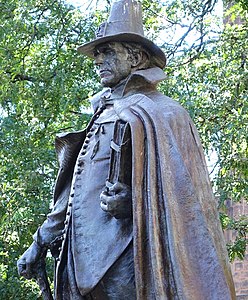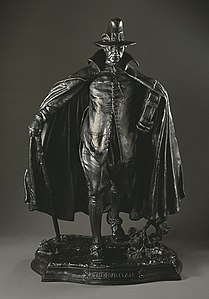
Augustus Saint-Gaudens was an Irish and American sculptor of the Beaux-Arts generation who embodied the ideals of the American Renaissance. Saint-Gaudens was born in Dublin to an Irish-French family, and raised in New York City. He traveled to Europe for further training and artistic study. After he returned to New York, he achieved major critical success for his monuments commemorating heroes of the American Civil War, many of which still stand. Saint-Gaudens created works such as the Robert Gould Shaw Memorial on Boston Common, Abraham Lincoln: The Man, and grand equestrian monuments to Civil War generals: General John Logan Memorial in Chicago's Grant Park and William Tecumseh Sherman at the corner of New York's Central Park. In addition, he created the popular historicist representation of The Puritan.

The Quadrangle is the common name for a cluster of museums and cultural institutions in Metro Center, Springfield, Massachusetts, on Chestnut Street between State and Edwards Streets.

The history of sculpture in the United States begins in the 1600s "with the modest efforts of craftsmen who adorned gravestones, Bible boxes, and various utilitarian objects with simple low-relief decorations." American sculpture in its many forms, genres and guises has continuously contributed to the cultural landscape of world art into the 21st century.

Samuel Chapin was a prominent early settler of Springfield, Massachusetts. He served the town as selectman, magistrate and deacon. Chapin is best known today as the subject of the Augustus Saint-Gaudens sculpture entitled Deacon Samuel Chapin.
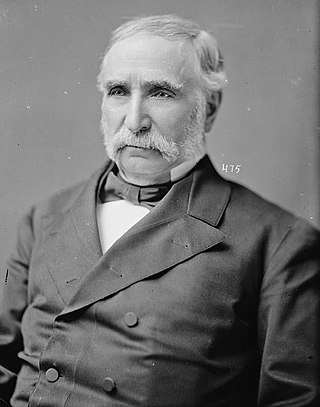
Chester William Chapin was an American businessman, president of the Boston and Albany Railroad from 1868 to 1878, and U.S. Congressman from Massachusetts. He was a multimillionaire at his death in 1883, and controlled one of New England’s most important rail lines.

Abraham Lincoln: The Man is a larger-than-life size 12-foot (3.7 m) bronze statue of Abraham Lincoln, the 16th president of the United States. The original statue is in Lincoln Park in Chicago, and later re-castings of the statue have been given as diplomatic gifts from the United States to the United Kingdom, and to Mexico.

Philip H. Martiny was a French-American sculptor who worked in the Paris atelier of Eugene Dock, where he became foreman before emigrating to New York in 1878—to avoid conscription in the French army, he later claimed. In the United States he found work with Augustus Saint-Gaudens, with whom he remained five years; a fellow worker in Saint-Gaudens' shop was Frederick MacMonnies. A group photograph taken in Saint-Gaudens's studio about 1883, conserved in the Archives of American Art, shows Kenyon Cox, Richard Watson Gilder, Martiny, Francis Davis Millet, Saint-Gaudens, Julian Alden Weir and Stanford White.

The Cornish Art Colony was a popular art colony centered in Cornish, New Hampshire, from about 1895 through the years of World War I. Attracted by the natural beauty of the area, about 100 artists, sculptors, writers, designers, and politicians lived there either full-time or during the summer months. With views across the Connecticut River Valley to Mount Ascutney in Vermont, the bucolic scenery was considered to resemble that of an Italian landscape.
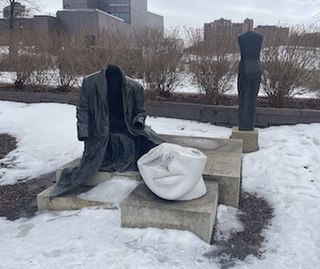
Judith Shea is an American sculptor and artist, born in Philadelphia, Pennsylvania, in 1948. She received a degree in fashion design at Parsons School of Design in 1969 and a BFA in 1975. This dual education formed the basis for her figure based works. Her career has three distinct phases: The use of cloth and clothing forms from 1974 to 1981; Hollow cast metal clothing-figure forms from 1982 until 1991; and carved full-figure statues made of wood, cloth, clay, foam and hair beginning in 1990 to present.
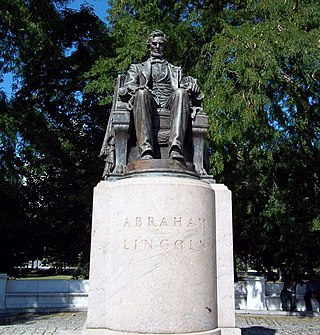
Abraham Lincoln: The Head of State is a 9-foot (2.7 m) tall bronze statue of Abraham Lincoln in Grant Park, in Chicago. Created by Augustus Saint-Gaudens and completed by his workshop in 1908, it was intended by the artist to evoke the loneliness and burden of command felt by Lincoln during his presidency. The sculpture depicts a contemplative Lincoln seated in a chair, and gazing down into the distance. The sculpture is set upon a pedestal and a 150-foot (46 m) wide exedra designed by architect Stanford White.

Louis Saint-Gaudens was an American sculptor of the Beaux-Arts generation. He was the brother of renowned sculptor Augustus Saint-Gaudens; Louis later changed the spelling of his name to St. Gaudens to differentiate himself from his well-known brother.
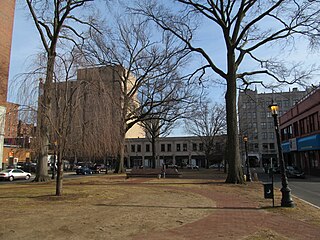
Stearns Square is an urban, city square located in Springfield, Massachusetts, United States, in the heart of Metro Center's Club Quarter. It was designed by the sculptor Augustus Saint-Gaudens and the landscape architect Stanford White, to accompany Saint-Gaudens' statue, The Puritan.
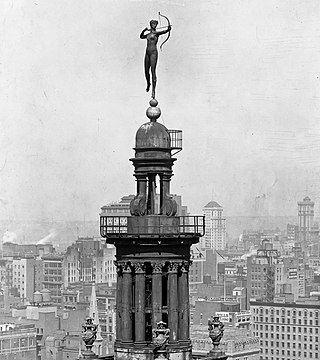
Diana – also known as Diana of the Tower – is an iconic statue by sculptor Augustus Saint-Gaudens, representing the goddess Diana. Once a major artistic feature of New York City, the second version stood atop the tower of Madison Square Garden from 1893 to 1925. Since 1932, it has been in the collection of the Philadelphia Museum of Art.

Admiral David Glasgow Farragut, also known as the Admiral Farragut Monument, is an outdoor bronze statue of David Farragut by Augustus Saint-Gaudens on a stone sculptural exedra designed by the architect Stanford White, installed in Manhattan's Madison Square, in the U.S. state of New York.
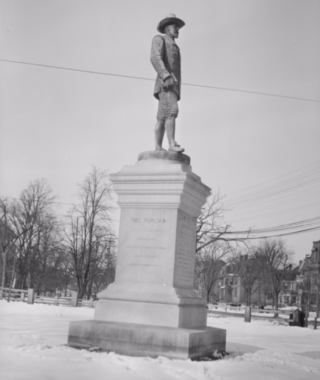
The John Bridge Monument, in the northeast corner of the Cambridge Common in Cambridge, Massachusetts, was given by Samuel James Bridge in honor of his ancestor John Bridge (1578–1665) and sculpted by Thomas R. Gould.
The City of Springfield, Massachusetts has two official symbols, and is also often represented by depictions of the Municipal Group as a de facto emblem of its government.

Springfield Cemetery is located in the Connecticut River Valley city of Springfield, Massachusetts. The cemetery opened in 1841 and was planned on the model of a rural cemetery. With the relocation of remains from the city's earliest burying ground, the cemetery became the final resting place for many of Springfield's 17th and 18th century pioneer settlers.

Hettie Anderson was an African-American art model and muse who posed for American sculptors and painters including Daniel Chester French, Augustus Saint-Gaudens, John La Farge, Anders Zorn, Bela Pratt, Adolph Alexander Weinman, and Evelyn Beatrice Longman. Among Anderson's high-profile likenesses are the winged Victory figure on the Sherman Memorial at Grand Army Plaza in Manhattan, New York City and $20 gold coins known as the Saint-Gaudens double eagle. Theodore Roosevelt deemed Victory "one of the finest figures of its kind." Saint-Gaudens described Anderson as "certainly the handsomest model I have ever seen of either sex" and considered her "Goddess-like."

The Christopher Lyman Magee Memorial is a public memorial in the Oakland neighborhood of Pittsburgh, Pennsylvania, United States. Located outside of the Carnegie Library of Pittsburgh in Schenley Park, the memorial honors Christopher Magee, a local political boss and philanthropist during the late 1800s. It was designed by sculptor Augustus Saint-Gaudens, with assistance from Henry Hering, while Stanford White and Henry Bacon served as architects for the project. The memorial was dedicated on Independence Day, July 4, 1908, before a crowd of two thousand spectators. It was one of the last works created by Saint-Gaudens, who died several months before its dedication.












